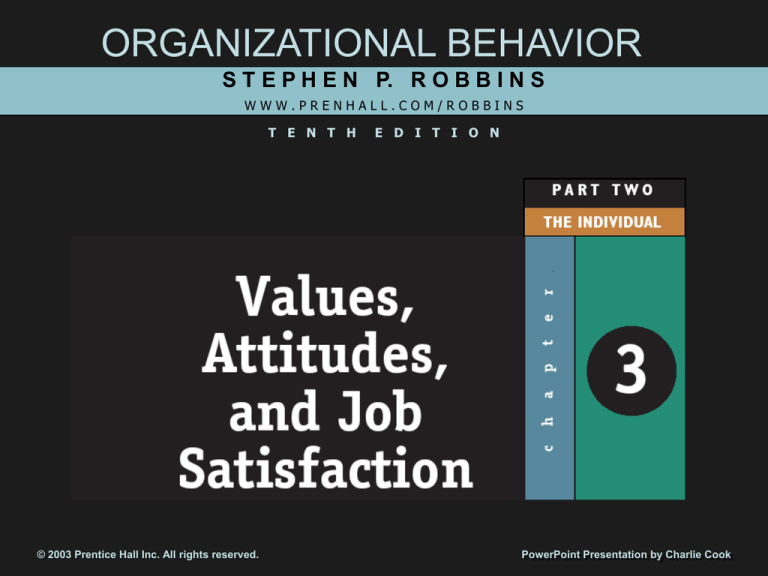
ORGANIZATIONAL BEHAVIOR
S T E P H E N P. R O B B I N S
WWW.PRENHALL.COM/ROBBINS
T E N T H
© 2003 Prentice Hall Inc. All rights reserved.
E D I T I O N
PowerPoint Presentation by Charlie Cook
OBJECTIVES
LEARNING
AFTER STUDYING THIS CHAPTER,
YOU SHOULD BE ABLE TO:
1. Contrast terminal and instrumental values.
2. List the dominant values in today’s workforce.
3. Identify the five value dimensions of national
culture.
4. Contrast the three components of an attitude.
5. Summarize the relationship between attitudes
and behavior.
6. Identify the role consistency plays in attitudes.
© 2003 Prentice Hall Inc. All rights reserved.
3–2
7. State the relationship between job satisfaction
and behavior.
8. Identify four employee responses to
dissatisfaction.
LEARNING
O B J E C T I V E S (cont’d)
AFTER STUDYING THIS CHAPTER,
YOU SHOULD BE ABLE TO:
© 2003 Prentice Hall Inc. All rights reserved.
3–3
Values
© 2003 Prentice Hall Inc. All rights reserved.
3–4
Types of Values –- Rokeach Value Survey
© 2003 Prentice Hall Inc. All rights reserved.
3–5
Values in
the
Rokeach
Survey
EXHIBIT
© 2003 Prentice Hall Inc. All rights reserved.
3-1a
3–6
Values in
the
Rokeach
Survey
(cont’d)
EXHIBIT
© 2003 Prentice Hall Inc. All rights reserved.
3-1b
3–7
Mean Value Rankings of
Executives, Union Members,
and Activists
EXHIBIT
© 2003 Prentice Hall Inc. All rights reserved.
3-2
3–8
Dominant Work Values in Today’s Workforce
EXHIBIT
© 2003 Prentice Hall Inc. All rights reserved.
3-3
3–9
Values, Loyalty, and Ethical Behavior
Ethical Values and
Behaviors of Leaders
Ethical Climate in
the Organization
© 2003 Prentice Hall Inc. All rights reserved.
3–10
Hofstede’s Framework for Assessing Cultures
© 2003 Prentice Hall Inc. All rights reserved.
3–11
Hofstede’s Framework (cont’d)
© 2003 Prentice Hall Inc. All rights reserved.
3–12
Hofstede’s Framework (cont’d)
© 2003 Prentice Hall Inc. All rights reserved.
3–13
Hofstede’s Framework (cont’d)
© 2003 Prentice Hall Inc. All rights reserved.
3–14
Hofstede’s Framework (cont’d)
© 2003 Prentice Hall Inc. All rights reserved.
3–15
The GLOBE
Framework
for
Assessing
Cultures
• Assertiveness
• Future Orientation
• Gender differentiation
• Uncertainty avoidance
• Power distance
• Individual/collectivism
• In-group collectivism
• Power orientation
• Humane orientation
EXHIBIT
3-4
© 2003 Prentice Hall Inc. All rights reserved.
3–16
Attitudes
© 2003 Prentice Hall Inc. All rights reserved.
3–17
Types of Attitudes
© 2003 Prentice Hall Inc. All rights reserved.
3–18
The Theory of Cognitive Dissonance
Desire to reduce dissonance
• Importance of elements creating dissonance
• Degree of individual influence over elements
• Rewards involved in dissonance
© 2003 Prentice Hall Inc. All rights reserved.
3–19
Measuring the A-B Relationship
Recent research indicates that the attitudes (A)
significantly predict behaviors (B) when moderating
variables are taken into account.
Moderating Variables
• Importance of the attitude
• Specificity of the attitude
• Accessibility of the attitude
• Social pressures on the individual
• Direct experience with the attitude
© 2003 Prentice Hall Inc. All rights reserved.
3–20
Self-Perception Theory
© 2003 Prentice Hall Inc. All rights reserved.
3–21
An Application: Attitude Surveys
© 2003 Prentice Hall Inc. All rights reserved.
3–22
Sample Attitude Survey
EXHIBIT
© 2003 Prentice Hall Inc. All rights reserved.
3-5
3–23
Job Satisfaction
Measuring Job Satisfaction
– Single global rating
– Summation score
How Satisfied Are People in Their Jobs?
– Job satisfaction declined to 50.7% in 2000
– Decline attributed to:
• Pressures to increase productivity
• Less control over work
© 2003 Prentice Hall Inc. All rights reserved.
3–24
The Effect of Job Satisfaction on Employee
Performance
Satisfaction and Productivity
– Satisfied workers aren’t necessarily more productive.
– Worker productivity is higher in organizations with
more satisfied workers.
Satisfaction and Absenteeism
– Satisfied employees have fewer avoidable absences.
Satisfaction and Turnover
– Satisfied employees are less likely to quit.
– Organizations take actions to cultivate high performers
and to weed out lower performers.
© 2003 Prentice Hall Inc. All rights reserved.
3–25
Responses to Job Dissatisfaction
EXHIBIT
© 2003 Prentice Hall Inc. All rights reserved.
3-6
3–26
How Employees Can Express Dissatisfaction
© 2003 Prentice Hall Inc. All rights reserved.
3–27
Job Satisfaction and OCB
Satisfaction and Organizational Citizenship Behavior
(OCB)
– Satisfied employees who feel fairly treated by and are
trusting of the organization are more willing to engage
in behaviors that go beyond the normal expectations of
their job.
© 2003 Prentice Hall Inc. All rights reserved.
3–28






